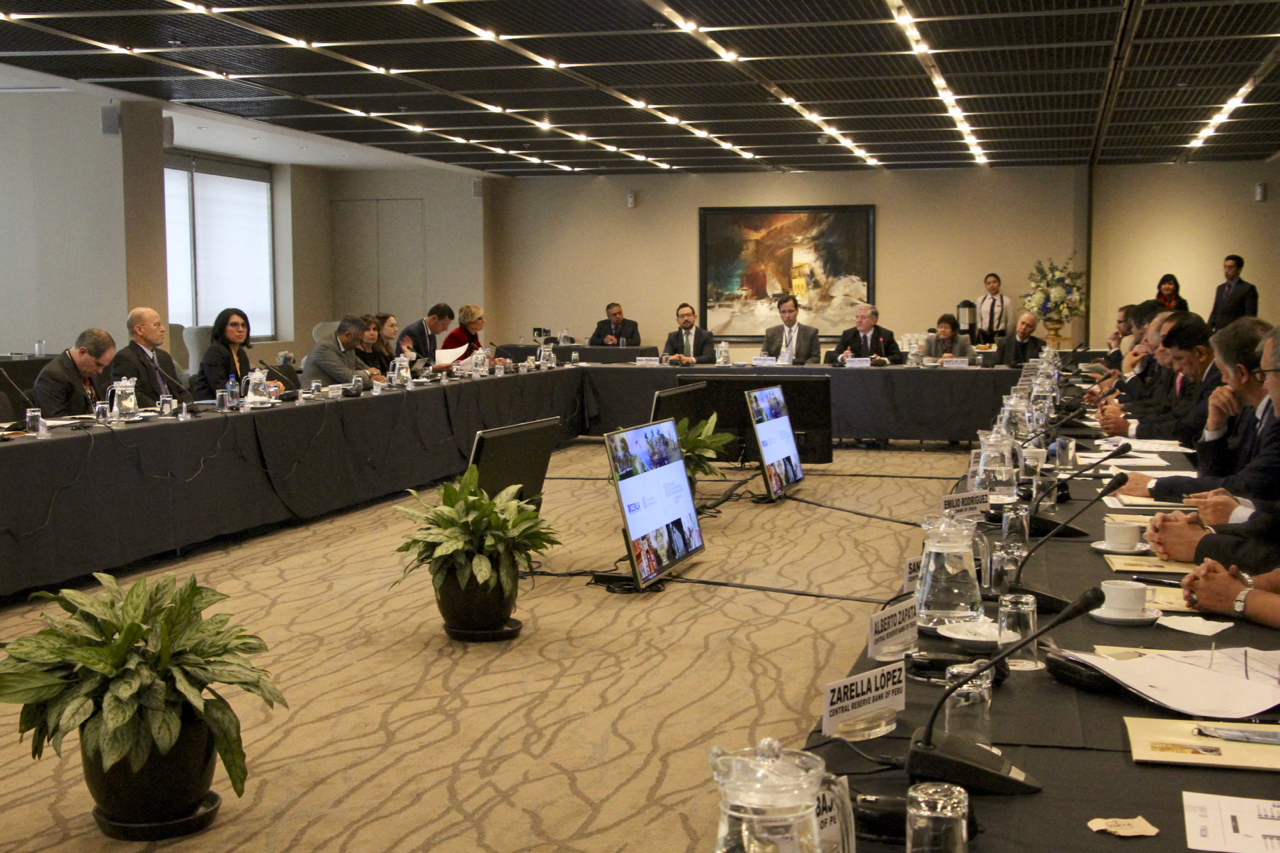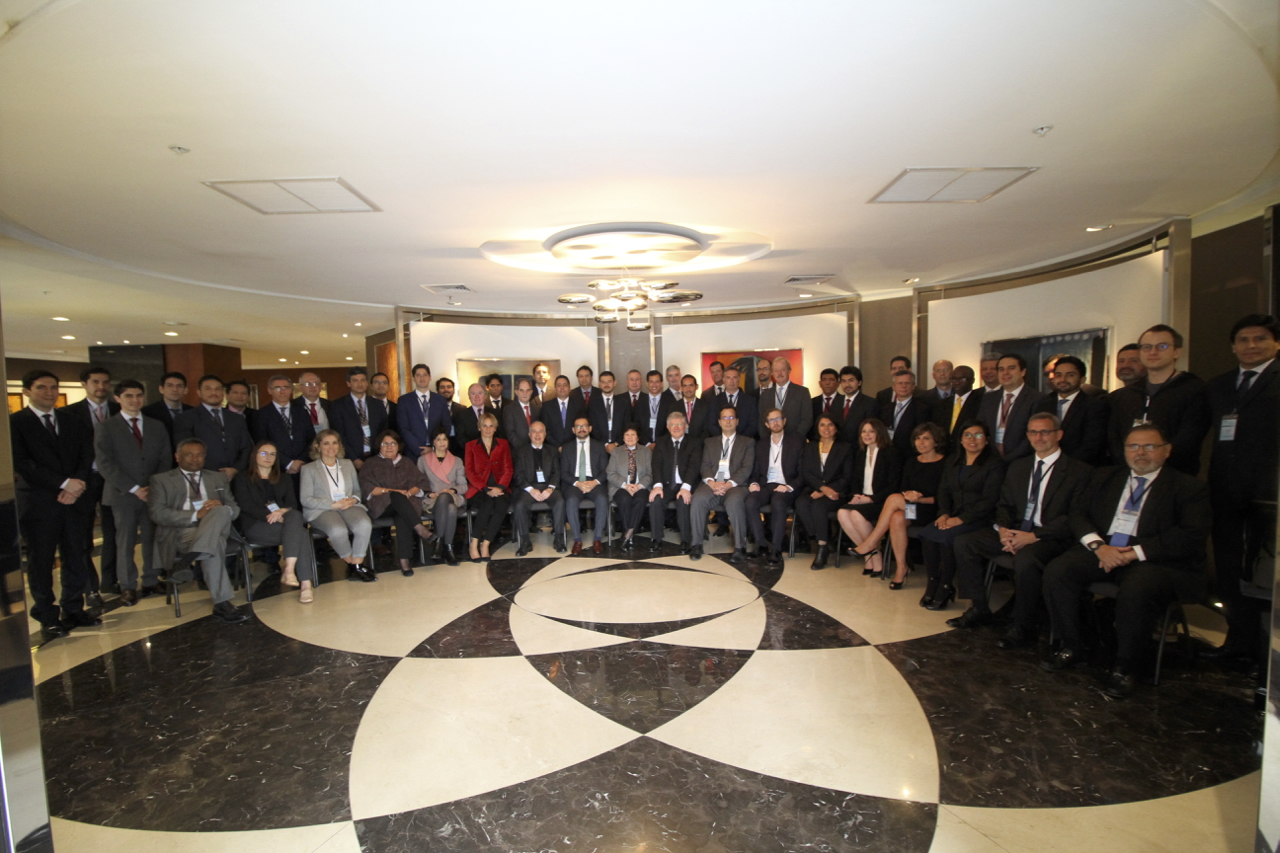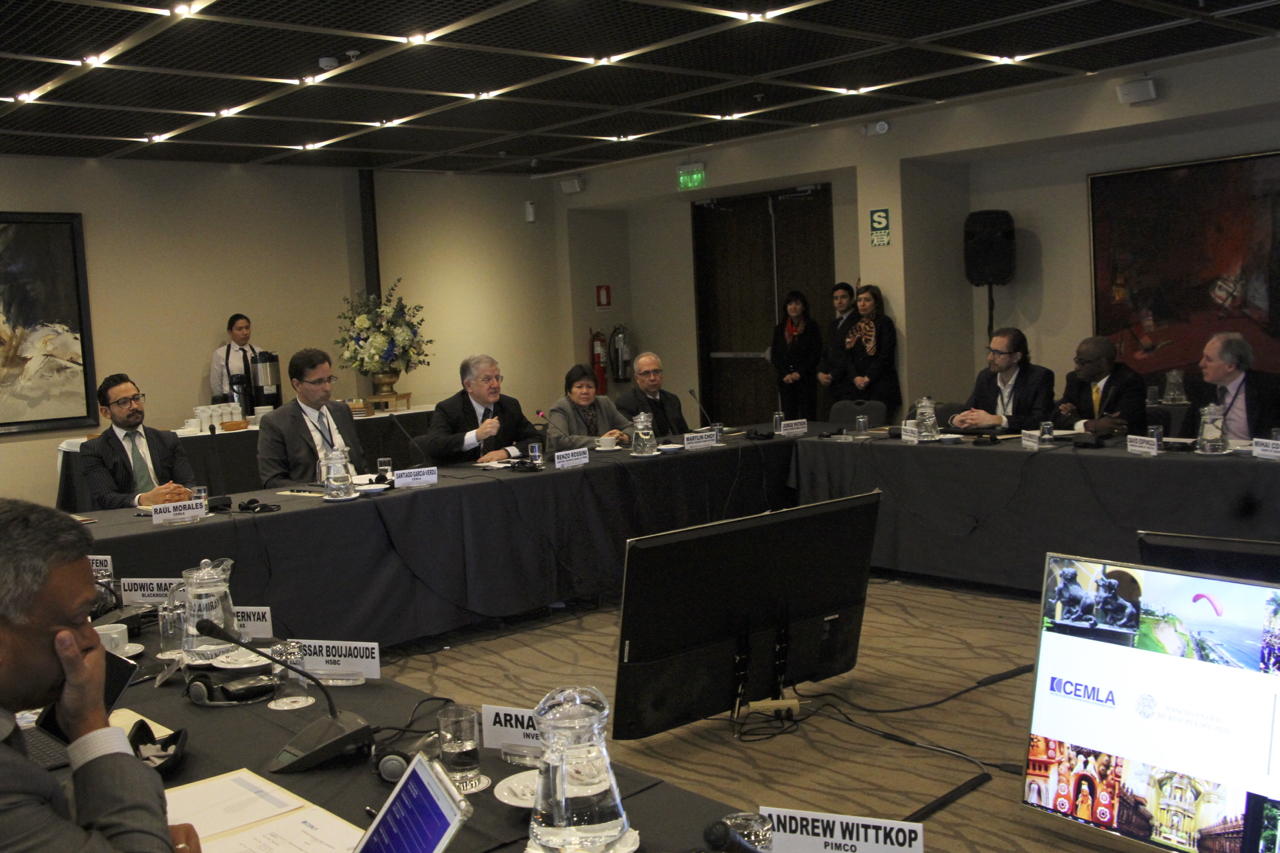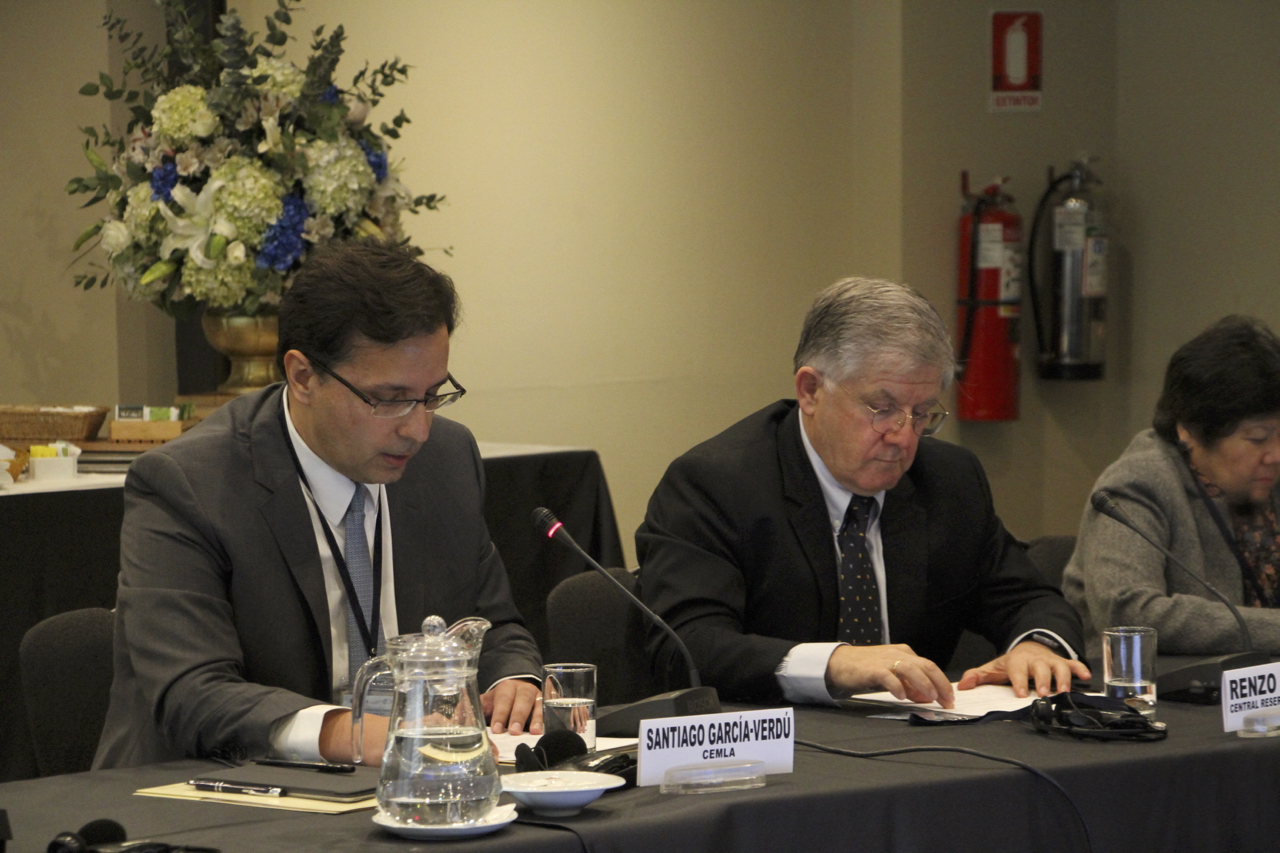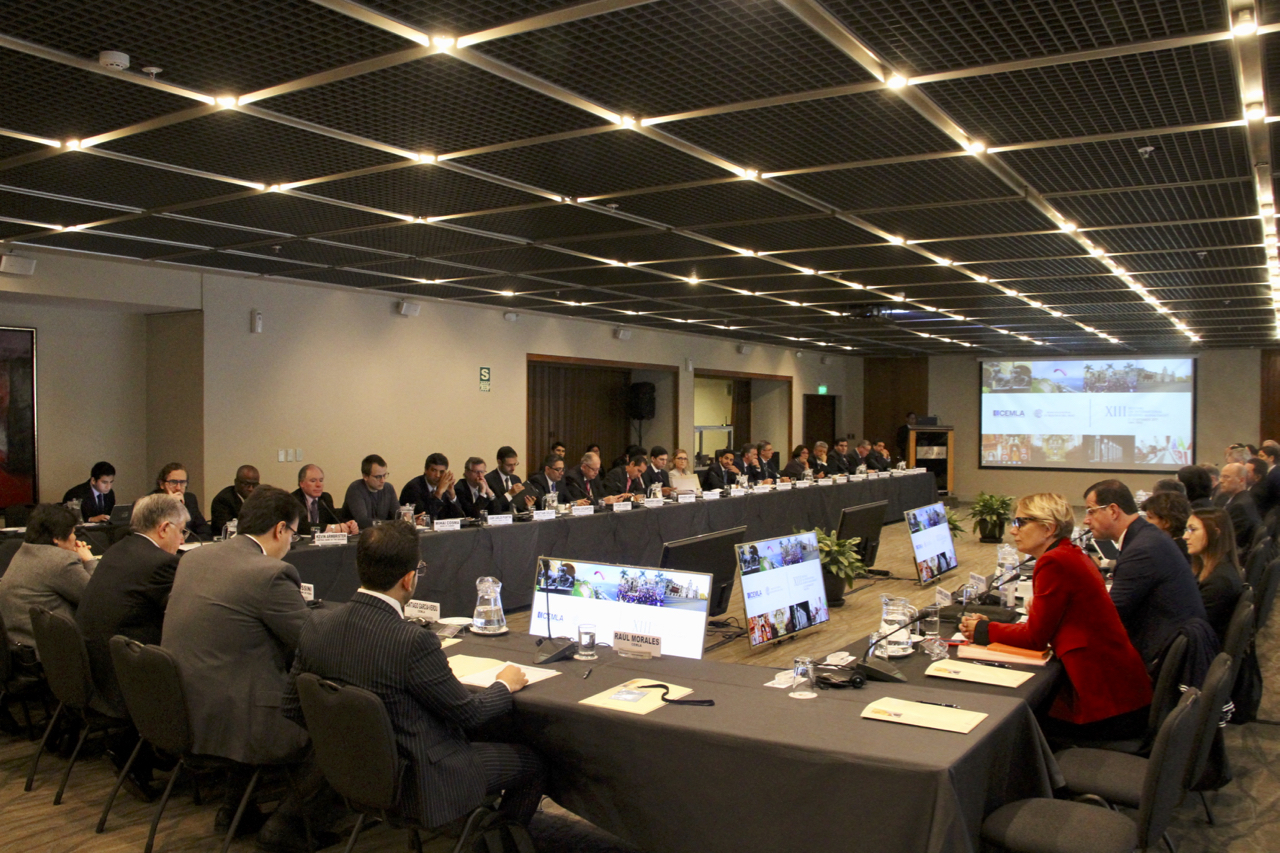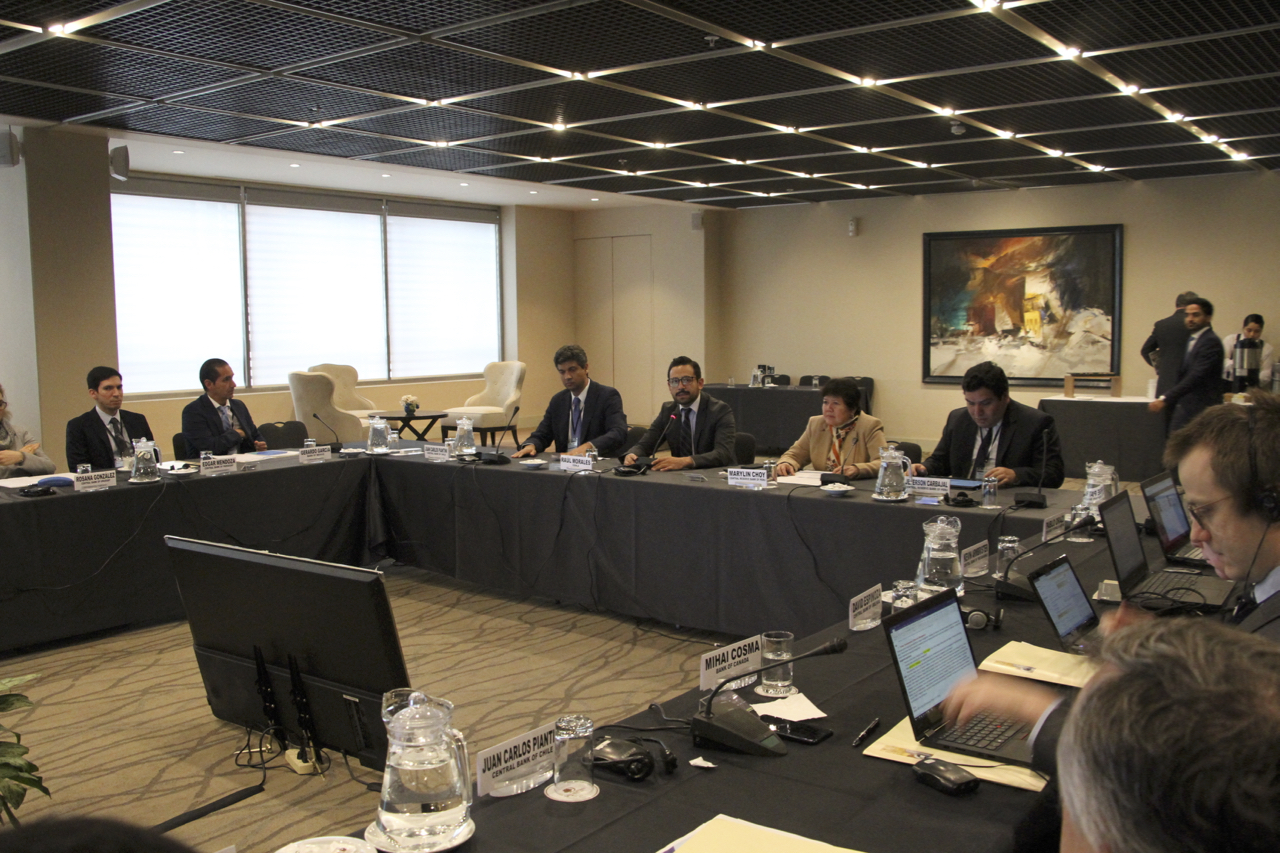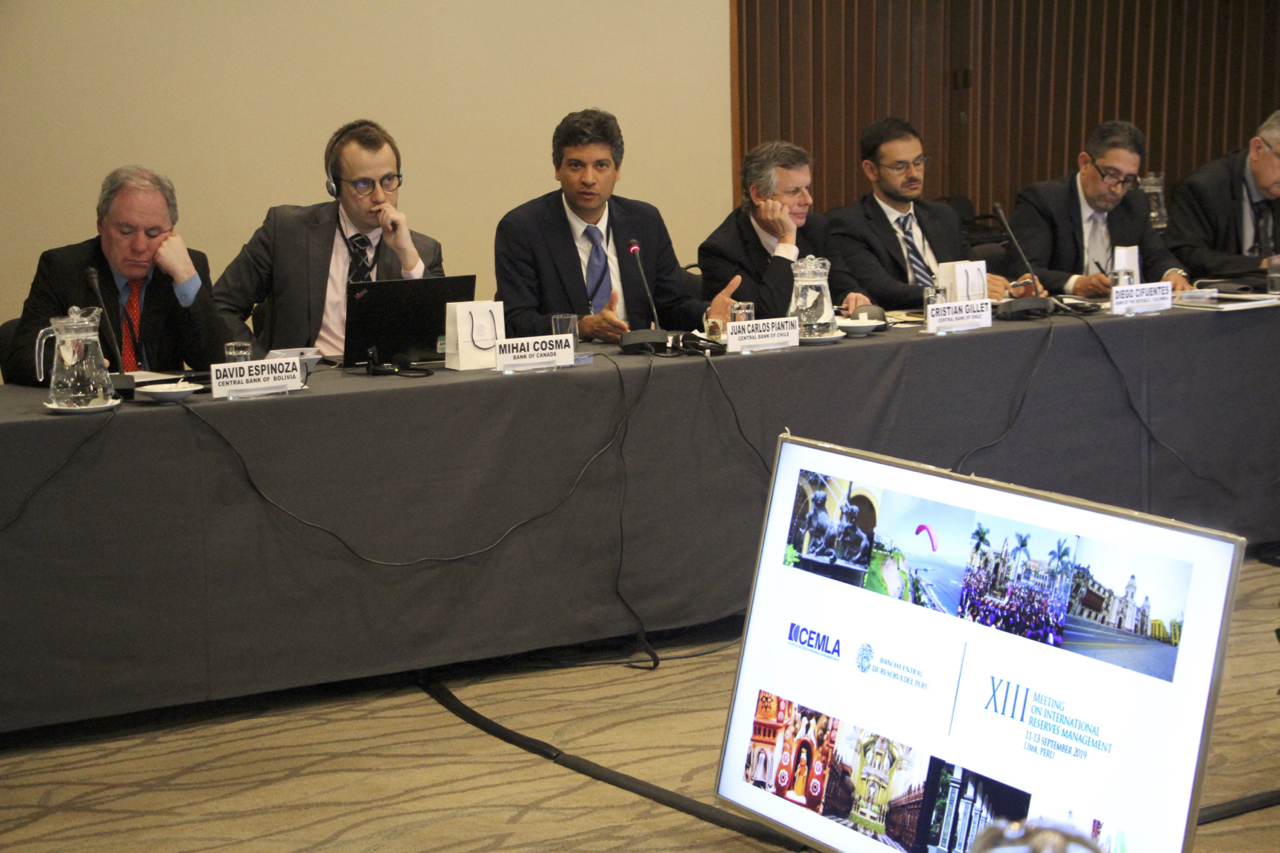XIII Meeting on International Reserves Management
Lima, Perú, September 11–13, 2019
The XIII Meeting on International Reserves Management of CEMLA was organized in joint with the Reserve Central Bank of Peru (BCRP) and it was held in Lima on September 11, 12 and 13, 2019. It was attended by over 70 participants representing 31 institutions, including central banks, multilateral organizations and industry players.
Key issues for central banks’ management of foreign reserves
Decision Making and Active Management
During this session, the central banks of Peru, Chile and Spain shared their respective frameworks, and decision-making process.
Among the issues discussed, it was argued that the institutional framework should enable a universe of eligible assets to allow for an active decision-making process, and to define an investment strategy suitable for the current international context. In tandem, it should procure an adequate risk profile.
As part of this framework, central banks may be able to establish objectives for their portfolio tranches, allowing a more dynamic management of reserves.
The reserve manager should balance maturity, liquidity and performance in line with the goals set by the decision body at the central bank, i.e., the Investment Committee. In addition, it should sensibly combine quantitative models with expert judgment to nourish the decision-making process.
To be better prepared, the central banks’ strategy should be based on risk factors. This is an approach that has shown significant advantages, to name a few: 1) it tends to be more intuitive in terms of economic and financial factors; 2) it helps reducing the dimensionality of the optimization problem; 3) it provides more robustness in terms of "corner solutions" and correlation structure. Furthermore, such an approach should help reserve managers in navigating the current changing waters.
It was concluded that central banks should take steps to become more flexible managers. It was also acknowledged that such steps will be plausible only if a greater institutional capacity is fostered in the reserves’ management teams.
Risk and data management
The central banks of Peru, Uruguay and the Fed NY discussed how important is to bring new risk and data management tools for the reserve’s management framework.
In general, there are two main challenges. The first one has to do with the availability of key information and how it is used; for instance, assessing the eligibility of (sovereign) assets, specifically how credit risk is calculated for certain eligible issuers; and, the liquidity of the instruments in which it can be invested, within what can be considered how to evaluate the relative liquidity of the eligible assets. It was underlined that using new technologies could help central banks to improve the use, recognition and management of information by different reserve management areas (back-office or accounting, mid- or risk analysis, front- or negotiating table).
Another challenge has to do with the quality of the data and, in this sense, for the optimization of a portfolio and individually choosing the assets in which to invest, complex models of analysis are required, which may need reliable information for the making decision process.
In the area of risk management, this is an element that it is not well implemented, can become an operational or conceptual hurdle. Some gaps that deserve more attention include, for instance, discretionary choices with respect to eligible sovereigns, considering assets not taken into account by the portfolio selection process, and streamlining the modeling process by exploring specific risk/return tradeoffs.
Strategic Asset Allocation models
This session was led by the central banks of Argentina, Colombia, Mexico and Peru. It was focused on the most relevant developments for Strategic Asset Allocation (SAA) models used by reserves managers of the region.
Central banks are called to continuously work toward improving of their SAA’s capability and performance. This will allow reserve managers to strengthen their allocation tactics based on the liquidity, safety and capital preservation objectives set by the central bank. This is particularly important in times of stress. Another benefit of setting an adjusted-SAA is the ability to better assess the extent to which their strategy exposure to possible risk factors, in particular, those associated with long time horizons.
Thus, it was shown how market indicators are useful to have an aggregate view of expected returns, and adequately understand the evolution of eligible assets over time. Likewise, setting optimization process under several scenarios allows to conceive optimal allocations under several contingencies. This is of relevant to determine the minimum and maximum allocation for each asset class. Many of these adjustments could result in a reallocation of the benchmark portfolio, increasing these instruments’ weights as better conditions are perceived over time. This has been the case for the US 5-10 years Treasury Bonds.
In sum, a dynamic SAA framework helps to capture key aspects of the investment policy, bearing in mind a vast number of scenarios. This might shed some light on the relative benefits between an inhouse SAA framework and the potential use of external managers.
Other key developments
This session comprised presentations from the BIS and the World Bank (WB).
The WB presented the main findings of a survey tailored to reserve managers. As known, central banks are managing significantly higher amounts of foreign reserves, yet, the opportunity for reserve managers to earn satisfactory yields by only investing in high-quality fixed-income assets (e.g. government paper issued by major AEs) has decreased significantly. In this vein, it has been found that central banks are considering investing in financial instruments valued in renminbi (RMB), but on a limited scale. It was also mentioned that a significant number of central banks reported more diversified portfolios with exposure to non-traditional asset classes, including corporate credit, mortgage-backed securities or equities, although mostly in limited allocations.
The WB presentation supported some of the discussions held in previous session, noting that more central banks around the world are adopting active approaches, including SAA and enhanced indexation, the review of the governance and risk management. The latter entails preserving the transparency of their reserve management operations.
The presentation of the BIS explored some possible future investment strategies, considering the possibility that the yields of the main fixed income instruments continue to drop. It is worth noting that given the current situation, it may be convenient to consider increasing the duration of the instruments in which reserve managers may want to invest.
As is known, the framework, with which each central bank decides to use for reserves management, takes into account the relation between risks and possible returns, in a specific time horizon. Relatedly, the SAA and the TAA are approaches that could play an important role in meeting the central bank objectives, while accounting for institutional restrictions. In this context, it is important to have a comprehensive risk assessment (interest rate, market risk, foreign exchange risk, etc.), and consider a forward-looking perspective.
Policy roundtable on the future challenges for reserves managers
It was reiterated that the economic-financial conditions will be altering the objectives of the strategy triangle (i.e., liquidity, capital preservation and return). For instance, the investment horizon is increasing and new assets are being considered. There is also evidence that the regional central banks are better equipped to adopt and use SAA models, but priorities and challenges in each country differ. Therefore, approaches might vary across Latin American and Caribbean Central Banks.
Reserve managers are increasingly developing alternative benchmarks. Thus, they might be able to more resiliently respond to various market conditions, in an increasingly challenging context. Moreover, reserves managers concluded that it could be also necessary to completely revise their mandate or, at least, raising the authorities’ awareness to obtain more flexibility in terms of the strategy and tactics.
As part of this scenario, it is necessary to rethink credit risk as a long-term issue, which lies ahead in view of the relative desynchronization in the economic cycle; in other words, diversification and risk factors may be subject to a thorough review. The low-rates scenario has forced central banks to consider if this historical trend may be leading to a new risk-return profile.
The way in which the objectives of reserve management varies with each central bank. This depends on the vulnerabilities and possible macro shocks. In addition, with the uncertain environment, LAC central banks are likely to have a greater need for foreign exchange intervention. These circumstances can have an effect on how central banks deal with the trade-off between performance, liquidity and capital preservation.
Given a scenario of a more segmented market, it is sensible to look into new markets, as some countries in the region have begun to do. The way in which Asian central banks are investing in LAC are cases in point in terms of the exploration of new opportunities. Shrewdness in the design of investment portfolios could also be an important step for central banks.
For its part, the industry has faced much pressure to provide meaningful solutions to central banks under the current setting. Moreover, some external asset managers might have a relative advantage given their knowledge of some key markets. However, it is necessary to establish clear objectives to operationalize an all-encompassing strategy. This involves adopting a sensible approach to assess the external managers’ contribution to the reserve management, providing a timeframe to verify that their objectives are being met.
On the other hand, it is relevant for international coordination between central banks with the support of multilateral institutions. This serves to strengthen technical capacity and lessons learned about portfolio management.
In addition, there are other changes in the industry that could bring about additional complexity, such as the change that is taking place with the LIBOR markets (now transiting SOFR) and its possible effects on the global asset management. Central banks that typically have an exposure to the LIBOR rate will have to follow up closely on plausible implications. Other regulatory changes that may take place (e.g., KYC, AML, NSFR, etc.) can have some repercussions for industry.
Finally, reserve managers should direct efforts to understand better how new financial technologies can contribute/affect to their tasks. In this context, a major issue is the presence of digital currencies (e.g., the JP Morgan Coin), which could become an eligible asset class, and for the possible implementation of investment tactics and strategies.
Public-private dialogue on foreign reserves management
A dialogue of private-public institutions was assembled, bringing together the views and experience of the asset management industry and the central banks’ reserves managers community.
The first session was devoted to discuss how the international context is bringing additional and new challenges to the asset management industry. The low interest rates environment and the sluggish recovery of advanced and emerging economies, together with the geopolitical risks, are some of the main aspects affecting the search for yield and, thus, the central banks’ reserves management.
In this respect, the current context for reserves management in LAC was presented. First, USD investments remain a safe haven, while the RMB is gaining presence only at a very slow pace. Second, as previously mentioned, reserve managers are keener to diversify into new asset classes and for that, in some cases, have approached external managers. In effect, the global interest rate outlook and the Fed policy are both important drivers for the industry.
The economic and financial conditions in Europe may lead the ECB to possibly change its monetary policy stance and, thus, have an impact on interest rates abroad. As part of the discussion, it was described how Emerging Market Economies (EME) are dealing with international factors, some of which are putting adverse pressure on trade, demand and growth. In particular, the discussion was focused on the implications for EME policy rates.
The second session was focused on other important developments that could have an impact in reserves management. Demographics and the fourth industrial revolution are factors that could play a significant role for asset management in the next years. This implies that a flexible active strategy could be relevant to assess new risk-adjusted return opportunities, and more importantly to allow for a more agile response to volatile and less liquid financial markets. This would be extremely relevant for reserves managers in LAC. This to consider new or additional weight in non-traditional currencies or assets, including gold, as well as to extend the investment time-horizon and the portfolio tranching.
To conclude, it was discussed how asset managers could be moving into the grounds of active management instead of passive, given the present macroeconomic, financial and political conditions. This may be particularly challenging in light of the operational hurdles and higher costs in a low interest rates environment.
* Summary elaborated by Raúl Morales Résendiz, Infrastructure and Financial Markets Manager.
Public-private dialogue on foreign reserves management
Welcome remarks
Renzo Rossini, Gerente General, Banco Central de Reserva del Perú
Santiago García Verdú, Adviser to the Director General, CEMLA
International context for reserves management
This session was devoted to highlight the current international issues related to asset management. Topics in this session was include, the U.S. economy, emerging market economies, market-moving news, and geopolitical challenges.
Moderator: Santiago García Verdú, CEMLA
Presenters:
James Law, UBS Asset Management ![]()
Monica Defend, Amundi Asset Management ![]()
International context for reserves management (continued)
Moderator: Santiago García Verdú, CEMLA
Presenters:
Marina Chernyak, BNP Paribas Asset Management ![]()
Elissar Boujaoude, HSBC Asset Management ![]()
Key industry developments
In this session, industry asset managers briefed the region´s central bankers on key market developments, delineating potential investment portfolio and instruments choices for reserves management.
Moderator: Jefferson Carbajal, Banco Central de Reserva del Perú
Presenters:
Arnab Das, Invesco ![]()
Ludwig Mareck, BlackRock ![]()
Key industry developments (continued)
Moderator: Zarella López, Banco Central de Reserva del Perú
Presenters:
Andrew Wittkop, PIMCO ![]()
Michael Albrecht, JP Morgan
Kurtulus Taskale Diamondopoulos, World Gold Council ![]()
Key issues for central banks’ management of foreign reserves
(central banks and official institutions only)
Decision making process and active management in an uncertain environment
This session focused on how central banks are managing their investment portfolios in an uncertain international context. Focus was on how reserve managers are dealing with global shocks.
Moderator: Raúl Morales Reséndiz, CEMLA
Presenters:
Marylin Choy, Banco Central de Reserva del Perú ![]()
Juan Carlos Piantini, Banco Central de Chile ![]()
Decision making process and active management in an uncertain environment (continued)
Moderator: Raúl Morales Reséndiz, CEMLA
Presenters:
Emilio Rodríguez, Banco de España
Risk and data management issues
This session provided an opportunity for reserve managers to learn about experiences on how risk management and data have been used as key inputs for decision making and investment portfolio allocation.
Moderator: Alberto Zapata, Banco Central de Reserva del Perú
Presenters:
Jeff Moore, Banco de la Reserva Federal de Nueva York
Omar Santivañez, Banco Central de Reserva del Perú ![]()
Risk and data management issues (continued)
Moderator: Guillermo Alarcón, Banco Central de Reserva del Perú
Ponente:
Rosana González, Banco Central del Uruguay ![]()
New trends in strategic asset allocation models
This session was devoted to exchange recent and relevant experiences from reserve managers on how their strategic asset allocation models are being shaped, and how this is reflected in their investment decisions.
Moderator: Raúl Morales Reséndiz, CEMLA
Presenters:
Gerardo García, Banco de México ![]()
Jorge Patrón, Banco Central de Reserva del Perú ![]()
New trends in strategic asset allocation models (continued)
Moderator: Raúl Morales Reséndiz, CEMLA
Presenters:
Diego Cifuentes, Banco de la República (Colombia) ![]()
Pablo Orazi, Banco Central de la República Argentina ![]()
Other key developments in asset management
This session was focused on fostering the exchange of experiences from central banks and guest official institutions on how the reserves management function is being transformed and what challenges may be coming.
Moderator: Sandra Mansilla, Banco Central de Reserva del Perú
Presenters:
Marco Ruiz, World Bank ![]()
Vahe Sahakyan, BIS ![]()
Policy roundtable on the future of foreign reserves at central banks
Closing remarks by CEMLA and BCRP
The Meeting on International Reserve Management have been organized since 1998 as a continuation of two seminars on the subject that had been carried out sporadically, to integrate into the CEMLA´s program the systematic approach of one of the central bank's critical functions. At that occasion, several methodologies and tools for the management of international reserves were analyzed, as well as the expected behavior of the markets for alternative investments and the relationship with funds managers.
The meetings have greatly benefited from the participation of the associated central banks and collaborators of CEMLA, Asian central banks, multilateral organizations (BIS, IMF and World Bank) and regional organizations (FLAR and SECMCA), as well as the technical collaboration of several advisers and financial companies involved in the management of international reserves: JP Morgan, Fischer, Francis, Trees & Watts, Inc, Risk Metrics Group, BBVA, Lehman Brothers, Bloomberg, State Street Global Advisors Limited, Goldman Sachs Asset Management, UBS Asset Management, Barclays Global Investors (BGI), HSBC, Morgan Keegan, Western Asset Management Co, CME Group, BNP Paribas Asset Management, HSBC, PIMCO, Amundi Asset Management and BlackRock.
James Law, UBS Management – Head of US Enhanced Cash and Short Duration Managing Director
Jim is responsible for the U.S. enhanced cash and short duration fixed income portfolios. He has led this group for 11 years, has been with the firm for 20 years and has 33 years of investment industry experience. His primary responsibilities are oversight of the group, portfolio strategy and risk budgeting to generate alpha, portfolio management, capital market analysis, client presentations, and business development.
Prior to joining the firm in 1999, James managed a USD 1.5 billion enhanced cash strategy in the pension trust division of Ameritech Corporation in Chicago, along with US/non-US fixed income allocation responsibilities totaling USD 3 billion. In addition, he managed a USD 1 billion arbitrage bond portfolio along with treasury market-making responsibilities in the 10-30 year sector for a large bank.
James is the head of the US Short Duration Strategy Group and a member of the Americas Fixed Income Management Committee. He is a member of the CFA Institute and the CFA Society of Chicago.
Monica Defend, Chief Strategist, Deputy Head of Group Research and Macro Strategy at Amundi
Monica, is currently Deputy Head of Group Research and member of the Global Investment Committee, contributes to the definition of Amundi’s investments strategy on financial markets.
The Strategy team relies on a strong quantitative approach: it analyses the trends and fluctuations of financial markets in order to define short-, mediumand long-term forecasts, highlighting the main investment themes. A distinctive feature of the Strategy team is the tight collaboration with the investment platforms for the generation of integrated investment ideas.
After being a University assistant for the Advanced Econometrics department, Monica started her carrier in the investmentA industry in 1997. Prior to her current role, she was Global Head of Asset Allocation Research and previously, Head of Quantitative Research at Pioneer Investments.
Monica graduated with full marks at Bocconi University. She holds Master’s degrees in Economics and Financial Economics from the London Business School and Bocconi University. Furthermore, she was selected for the UniCredit Young Talents Program, obtaining afterwards an MBA degree at the London Business School.
Marina Chernyak, BNP Paribas Asset Management
Marina Chernyak is an Emerging Markets Economist at BNP Paribas Asset Management. Marina is responsible for analysis and forecasting macroeconomic developments in emerging markets, supporting the Emerging Markets Fixed Income team.
Marina joined the firm in October 2017 and is based in London. Marina started her career at Moore Capital Management in New York in 2008 as a research analyst for the US economy for three years before moving to Moore Europe Capital Management in London for six years, where she was responsible for research of Central/Eastern-European and Non-Japan Asian Emerging Markets.
Marina received her B. A. in Mathematical Economics and International Development Summa Cum Laude from the City University of New York.
Elissar Boujaode, HSBC – Head of Coverage for Central Banks and Public Pensions in the Americas
Joined HSBC Global Banking and Markets in April 2013, bringing over 25 years industry experience in Securities Markets, Investment Management and Banking. She is currently Head of Coverage for Central Banks and Public Pensions in the Americas acting as a focal point to bring HSBC Group’s products globally to the Americas’ Asset Owners.
Prior to HSBC, over the course of 13 years, Elissar held senior roles in the Investment management Industry in Fixed Income Research, Asset Allocation and Product Management at firms such as TCW, PIMCO and AXA Investment Management. In the Securities Industry, Elissar worked as a Fixed Income publishing analyst at Goldman Sachs and Lehman Brother in New York and London from 1990 through 1999 covering the Financial Sector and Sovereigns. Prior to her securities research career, Elissar worked for three years in commercial banking, in Boston Massachusetts, including the completion of a formal credit training program with a focus on distressed debt sovereigns. Miss Boujaoude earned a Bachelor of Science in Business Administration from the University of Massachusetts (1987 Summa Cum Laude). She has also completed an Executive Seminar in Investment Decisions and Behavioural Finance from the Harvard Kennedy School.
Arnab Das, Invesco, Global Market Strategist and Invesco’s Head of EMEA thought leadership team
Arnab Das is Global Market Strategist in the EMEA region, based in London, and a member of Invesco’s Global Thought Leadership team. He helps develop and communicate analysis and insight on the global economy and financial markets across asset classes for clients, media, governments and central banks. He works with Invesco’s investment teams across disciplines and regions and is a member of Invesco’s Global Investor Forum Advisory Council with a focus on global macro and emerging markets. Arnab’s research interests span economic policy, performance and reform; and economic and financial history.
Arnab joined Invesco in 2015 as Head of EM macro research for Invesco Fixed Income. He began his career in finance in 1992, and has served as Co-head of Economic Research & Strategy at Roubini Global Economics; Co-head of Global Economics & Strategy, Head of Global FX Research, and Head of EM Economics & Strategy at Dresdner Kleinwort; and Head of EEMEA Research at JP Morgan. He has also been a private consultant in global and emerging markets, as well as consulting with Trusted Sources, a specialist EM research boutique.
Arnab’s studies were in macroeconomics, economic history and international political economy. He received an AB from Princeton University in 1986 and completed his postgraduate and doctoral work at the London School of Economics in 1987-1992.
Ludwig Marek, BlackRock
Managing Director, is Head of USD Short Duration Product Strategy and a senior member of the Multi-Sector Fixed Income Product Strategy Team within BlackRock's Global Fixed Income group. Based in New York, he is dedicated to the firm's USD short duration investment capabilities and product offering. Mr. Marek joined BlackRock in 2013 and is responsible for the expansion of the USD Short Duration business both in product range and global footprint, which helped broaden the platform's investor base both domestically and across EMEA, Latin America and Asia.
Prior to joining BlackRock, Mr. Marek was Vice President of Fixed Income Product Management at Citigroup's hedge fund Citi Capital Advisors (CCA). Before joining CCA in 2011, Mr. Marek was the Lead Marketing Strategist at Goldman Sachs Asset Management (GSAM) for all fixed income mutual funds and money market products. He was also a Vice President of Global Institutional Marketing at Knight Capital Group prior to GSAM and held various positions as a financial journalist at BridgeNews, AFX-News and Bloomberg, covering capital markets, monetary policy and investment strategies.
Mr. Marek earned an MPA in Economic Policy Management in Emerging Markets from Columbia University in 2007 and a BA in English Literature from the University of Massachusetts at Lowell in 1998. Mr. Marek holds the Series 7 and 63.
Andrew Wittkop, Executive Vice President and Portfolio Manager, PIMCO
Mr. Wittkop is an executive vice president and portfolio manager in the Newport Beach office, focusing on Treasury bonds, agencies and interest rate derivatives. He previously worked on the real return desk. Prior to that, he was a portfolio analyst with the global portfolio management team and a product manager for absolute return strategies. He has 19 years of investment experience and holds an MBA from Stern School of Business at New York University and an undergraduate degree from the University of California, Los Angeles.
Michael Albrecht, JP Morgan
Michael Albrecht, vice president, is a global strategist in the Multi-Asset Solutions team, based in New York. He is responsible for formulating and communicating the group's economic views and asset allocation strategy, and also serves on the committee that produces the Long-Term Capital Market Assumptions underpinning J.P. Morgan's strategic asset allocation process. An employee since 2011, Michael worked previously as a quantitative equity researcher at the Quantitative Services Group (now Markit). Michael obtained a B.Sc. in Computational Finance and Statistics from Carnegie Mellon University and is a CFA charterholder.
Kurtulus Taskale Diamondopoulos, Director, Central Banks and Public Policy, World Gold Council
Kurtulus was formerly the Deputy Director of the FX Transactions Division, Markets Department of the Central Bank of the Republic of Turkey. Kurtulus worked at the central bank for 25 years holding various positions within the Markets Department as a reserve and risk management professional. She holds a BA degree in Economics from Middle East Technical University, Ankara and an MA in International Economics and Finance from Brandeis University, Boston.
Marylin Choy, Banco Central de Reserva de Perú
Ms. Choy studied Economics at the National University of San Marcos (1980) and Magister in Economics at Rice University (1982).
Marylin Choy has followed several training courses abroad (with Central Banks, World Bank, CEMLA, World Development Institute, BIS, FLAR, IBCA Limited, German Foundation, ECLAC, Studienzentrum Gerzensee, IMF and Chamber of Commerce and Industry of Bordeaux) and in the country (Global Partners, IPAE, UNMSM, ESAN, among others).
Previously he served as Manager of Credit and Financial Regulation (December 1990 - June 1994), Assistant Manager of the Monetary Sector (March 1984 - February 1989 and May 1989 - December 1990) and Head of the Department of Programming and Financial Analysis (July 1982 - March 1984). He also worked in the Financial Analysis and Programming Department, Financial Programming and Analysis Section and Banking Financial Institutions Section of Banco Central de Reserva de Peru.
Marylin Choy joined the Bank in May 1977 after successfully completing the XXIV University Extension Course of the BCRP.
Juan Carlos Piantini Cardoso, Banco Central de Reserva de Perú
Mr Piantini, is the International Markets Manager for the Central Bank of Chile since July 2017. Between March 2007 and June 2017 he held various management positions beginning with Head of the Fiscal Agency; Head of the International Trading Desk; and Head of the Investment Strategy Departments. As a whole, these positions included the responsibilities for designing and implementing the investment strategies of the Chilean Sovereign Wealth Funds and the International Reserves of the Central Bank of Chile. Between 2005 and 2007 he worked for BCI Stock Brokers and was in charge of the domestic fixed income portfolio. Between 2003 and 2005 he worked as a broker in the International Trading Desk for the international fixed income portfolio of the international reserves at the Central Bank of Chile.
Mr. Piantini graduated as Economist from Universidad de Santiago and later on, he got a Master degree on financial economics at the same university. He has also developed an academic curriculum contributing to several universities giving courses for graduate and undergraduate students on economics and finance.
Emilio Rodríguez, Head of Asset Management Division, Banco de España.
Mr. Emilio Rodríguez, CFA, is currently Head of the Asset Management Division, within the Market Operations Department, at Banco de España. He leads a team involved in the management of euro denominated assets and foreign reserves portfolios and is also in charge of the implementation of the Eurosystem asset purchase programs. He received his Bachelor in Economics from Universidad Complutense and MSc in Economics and Markets from Universidad Carlos III in Madrid. He joined the Spanish national central bank in 2005 as a portfolio manager, after a career in the private sector with varied responsibilities in the capital markets and finance areas in banking and corporate firms. He has published several articles in domestic journals and is co-author of a book on fixed-income active portfolio management.
Jeffrey Moore, Director, Federal Reserve Bank of New York
Jeff is the Director of Counterparty & Risk Management within the Markets Group at the Federal Reserve Bank of New York. In this capacity, he manages the 180+ counterparty relationships employed by the markets desk to implement monetary policy and advises on risk issues across trading operations. Prior to this role, he held a range of positions within the Federal Reserve System spanning research, bank supervision, credit, payment systems and portfolio management. He also worked in the private sector as a consultant for a number of years. He holds BA, MA and PhD degrees in economics from Emory University.
Rosana González, Senior Analyst, Banco Central del Uruguay
I’ve worked Banco Central del Uruguay for 15 years in the Middle Office Department. Actually, I’m Senior Analyst.
I’m an Economist, with a Master in Finances. I have approved CFA 1st level too.
I have attended different workshops at the World Bank related to portfolio management and risk management. The last was about Mortgage Backed Securities (MBS). I have also attended other instances of CEMLA training, as well as New York Institute of Finance (NYIF) online training.
Gerardo García, Director of International Operations at Banco de México
Involved in the design and implementation of strategies for the investment of the 175 billion US dollar international reserves portfolio for over 19 years. Invested in fixed income securities, currencies, commodities, and financial derivatives on a global basis.
Executed the world´s largest oil hedging program using sophisticated OTC derivatives in international financial markets.
Jorge Patrón, International Operations Manager, Banco Central de Reserva del Perú
Mr. Patron studied Economics at the Pontifical Catholic University of Peru, has a Master's degree in Economics from Northwestern University (1994) and has participated in various international courses and seminars organized by FLAR, The Royal Bank of Scotland, CEMLA, Federal Reserve Bank of New York, among others. He has also studied in the country, organized by the Universidad del Pacífico, Universidad Católica, Universidad de Lima, Reuters and the Association of Banks of Peru.
Jorge Patron joined the Bank in January 1988, after successfully completing the XXXIV University Extension Course of the BCRP.
Diego Cifuentes, Banco de la República, Colombia
Diego Cifuentes is the Director of the International Investments Department at the Central Bank of Colombia. He has worked in the Investment Department for over 18 years and has held multiple positions related with management of the country’s foreign reserves and sovereign wealth funds. Diego holds an MBA degree from Columbia Business School, is a CFA Charterholder and has obtained a Bachelor’s degree in Industrial Engineering from Los Andes University in Bogota.
Pablo Orazi, Banco Central de la República Argentina
In 2008, Mr. Orazi worked in the Reserve Administration area of the Central Bank as Portfolio Manager, progressively moving towards more quantitative parts of the area, and currently serves as Deputy Manager of Investment Alternatives Analysis. He has a Bachelor's degree in Economics (UBA, Buenos Aires, Argentina), with a Master's Degree in Finance (UTDT, Bs. As.), Postgraduate Degree in Quantitative Finance (UCEMA, Bs. As.) And a Master's Degree in Data Science with orientation in Finance (AFI, Madrid Spain).
Marco Antonio Ruiz Gil, Senior Financial Officer, Reserves Advisory and Management Program, World Bank Treasury
Marco Ruiz is an engagement manager in the World Bank Treasury’s Reserves Advisory and Management Program (RAMP). In this role, he helps official institutions to implement best practices in asset management. Prior to joining the World Bank, he managed Colombia’s foreign reserves and sovereign wealth funds for almost two decades. In the Central Bank, he started his career as portfolio manager, and later became Head of Portfolio Management and Director of International Investment. In this last position, he received the Reserve Manager of the Year award from Central Banking Publications in 2014. He holds a bachelor’s degree in economics from Universidad de los Andes in Bogota and a Master of Business Administration from New York University. He is a CFA charterholder.
Mr. Vahe Sahakyan, Senior Asset Management Specialist, BIS Banking Department
Vahe Sahakyan is a Senior Asset Management Specialist at the BIS Banking Department. He joined the BIS in 2008 as an Asset Management Specialist supporting BIS internal committees and central bank clients in strategic and tactical asset allocation, asset liability management and outsourcing. Before joining the BIS, he worked for the World Bank and the Central Bank of Armenia and taught econometrics and financial market microstructure at the Universitat Pompeu Fabra. Vahe Sahakyan holds several titles: PhD in Mathematical Methods (Yerevan State University), PhD candidate in Quantitative Finance (University of Zurich), MA in Economics (Central European University), and MSc in Finance (Universitat Pompeu Fabra).


